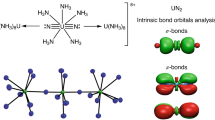Abstract
The crystal structures of (Nh4)11.5K0.5[ Eu(OH2)P5W30O110] ·24 H2O, K5H5 [Eu(OH2)P5W30O110] ·31 H2O, and (NH4)11[U(OH2)P5Wn30O110 ·12 H2O have been determined. In each case, the anion has the overall virtual C5v symmetry previously observed for the sodium derivative, [NaP5W30 110]14- The encrypted Eu3+ and U4+cations lie on the C5 axis, but are displaced further than the Na+ from the equatorial plane defined by the five phosphorus atoms. Only minor differences are observed between the structures of the two salts of the europium derivative, although solutions of these display31P NMR spectra with chemical shifts differing by 10 ppm, provisionally attributed to the effects of protonation of the anion, The most significant feature of the three new structures is the presence of a water molecule within the central cavity and coor-dinated to the Eu3+ or U4+ cation.The coordination spheres of the central cations can therefore be described as monocapped pentagonal antiprisms.
Similar content being viewed by others
References
C. Preyssler (1970). Bull. Soc. Chim. France 30.
M. H. Alizadeh, S. P. Harmalker, Y. Jeannin, J. Martin-Frére, and M. T. Pope (1985).J. Am. Chem. Soc. 107, 2662.
I. Creaser, M. C. Heckel, R. J. Nietz, and M. T. Pope (1993).Inorg. Chem. 32, 1573, and references therein.
M. R. Antonio and L. Soderholm (1994).Inorg. Chem. 33, 5988.
L. Soderholm, G. K. Liu, J. Munteau, J. Malinsky, and M. R. Antonio 1995.J. Phys. Chem. 99, 9611.
M. R. Antonio, J. Malinsky, and L. Soderholm (1995).Mater Res. Soc, Symp. Proc. 368, 223.
A. G. Siemens,XSCANS Users Manual, Version 2.18a (Siemens Analytical X-ray Instruments, Madison, WI, 1994.
G. M. Sheldrick,SHELXTL Structure Determination Software Programs (Siemens Analytical X-ray Instruments, Madison, WI, 1990).
R. D. Shannon (1976).Acta Cryst. A32, 751.
Extended Hückel Calculations performed for the Keggin compounds [(XO4)W12036]11- (X= B, Si, P, Ge) show that the oxygen atoms bound to the heteroatom (X bear the highest electronic density within the heteropolyanion structure. (a) S.-H. Wang and S. A. Jansen (1994). (Chem. Mater.6 (11), 2130; (b) S. A, Jansen, D. J. Singh, and S.-H Wang (1994). Chem. Mater. 6(2), 146.
J. P. Launay, M. Boyer, and F. Chauveau (1976).J. Inorg. Nucl. Chem. 38, 243.
J. P. Launay (1976).J. Inorg. Nucl. Chem. 38, 807.
C. Rong and M. T. Pope (1992).J. Am. Chem. Soc. 114, 2932.
Author information
Authors and Affiliations
Rights and permissions
About this article
Cite this article
Dickman, M.H., Gama, G.J., Kim, KC. et al. The structures of europium(III)- and uranium(IV) derivatives of [P5w3oo110]15-: Evidence for “cryptohydration”. J Clust Sci 7, 567–583 (1996). https://doi.org/10.1007/BF01165802
Issue Date:
DOI: https://doi.org/10.1007/BF01165802




